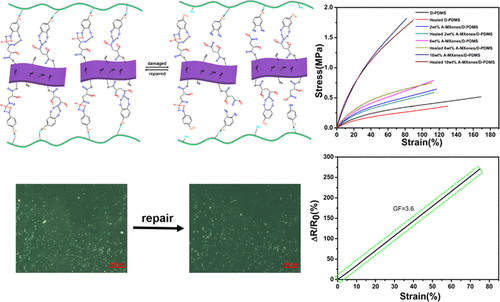当前位置:
X-MOL 学术
›
ACS Appl. Mater. Interfaces
›
论文详情
Our official English website, www.x-mol.net, welcomes your feedback! (Note: you will need to create a separate account there.)
Self-Healing Ti3C2 MXenes/PDMS Supramolecular Elastomer Based on Small Biomolecules Modification for Wearable Sensor.
ACS Applied Materials & Interfaces ( IF 9.5 ) Pub Date : 2020-09-14 , DOI: 10.1021/acsami.0c13653 Kaiming Zhang 1 , Jiawen Sun 2, 3 , Jingyao Song 1 , Chuanhui Gao 1 , Zhe Wang 1 , Chengxin Song 1 , Yumin Wu 1 , Yuetao Liu 1
ACS Applied Materials & Interfaces ( IF 9.5 ) Pub Date : 2020-09-14 , DOI: 10.1021/acsami.0c13653 Kaiming Zhang 1 , Jiawen Sun 2, 3 , Jingyao Song 1 , Chuanhui Gao 1 , Zhe Wang 1 , Chengxin Song 1 , Yumin Wu 1 , Yuetao Liu 1
Affiliation

|
Flexible conductive composites can be used as wearable strain sensors, which are widely used in the fields of new-generation robotics, electronic skin, and human detection. However, how to make conductive composites that simultaneously possess flexibility, stretchability, self-healing, and sensing capability is challenging research. In this work, we innovatively designed and prepared a silicone polymer conductive composite. MXenes and amino poly(dimethylsiloxane) were modified by small biomolecules via an esterification reaction and a Schiff base reaction, respectively. The modified MXenes are uniformly dispersed, which endows the composite with good electrical conductivity. The reversibility of multiple hydrogen bonds and imine bonds in the composite system makes it have ideal tensile properties and high-efficiency self-healing ability without external stimulation. The conductive composite containing 10 wt % A-MXenes showed an elongation of 81%, and its mechanical strength could reach 1.81 MPa. After repair, the tensile properties and the electrical conductivity could be restored to 98.4 and 97.6%, respectively. In addition, the conductive composite is further evaluated for the value of wearable strain sensors. Even after cut-healed processes, the conductive composite can still accurately detect tiny human movements (including speaking, swallowing, and pressing). This kind of self-healing MXene/PDMS elastomers based on the modification of small biomolecules has great potential as wearable strain sensors. This simple preparation method provides guidance for future multifunctional flexible electronic materials.
中文翻译:

基于可穿戴传感器的小生物分子修饰的自修复Ti3C2 MXenes / PDMS超分子弹性体。
柔性导电复合材料可用作可穿戴应变传感器,已广泛应用于新一代机器人技术,电子皮肤和人体检测领域。然而,如何制造同时具有柔韧性,可拉伸性,自愈性和感测能力的导电复合材料是一项具有挑战性的研究。在这项工作中,我们创新地设计和制备了有机硅聚合物导电复合材料。MXenes和氨基聚二甲基硅氧烷分别通过小生物分子通过酯化反应和席夫碱反应进行修饰。改性的MXenes均匀分散,赋予复合材料良好的导电性。复合系统中多个氢键和亚胺键的可逆性使其具有理想的拉伸性能和高效的自我修复能力,而无需外部刺激。包含10wt%的A-MXenes的导电复合材料显示出81%的伸长率,并且其机械强度可以达到1.81MPa。修复后,拉伸性能和电导率可以分别恢复到98.4和97.6%。另外,进一步评估导电复合材料的可穿戴应变传感器的价值。即使经过伤口愈合过程,导电复合材料仍可以准确地检测到人体的微小运动(包括说话,吞咽和按压)。这种基于小生物分子改性的自修复MXene / PDMS弹性体具有作为可穿戴应变传感器的巨大潜力。
更新日期:2020-10-07
中文翻译:

基于可穿戴传感器的小生物分子修饰的自修复Ti3C2 MXenes / PDMS超分子弹性体。
柔性导电复合材料可用作可穿戴应变传感器,已广泛应用于新一代机器人技术,电子皮肤和人体检测领域。然而,如何制造同时具有柔韧性,可拉伸性,自愈性和感测能力的导电复合材料是一项具有挑战性的研究。在这项工作中,我们创新地设计和制备了有机硅聚合物导电复合材料。MXenes和氨基聚二甲基硅氧烷分别通过小生物分子通过酯化反应和席夫碱反应进行修饰。改性的MXenes均匀分散,赋予复合材料良好的导电性。复合系统中多个氢键和亚胺键的可逆性使其具有理想的拉伸性能和高效的自我修复能力,而无需外部刺激。包含10wt%的A-MXenes的导电复合材料显示出81%的伸长率,并且其机械强度可以达到1.81MPa。修复后,拉伸性能和电导率可以分别恢复到98.4和97.6%。另外,进一步评估导电复合材料的可穿戴应变传感器的价值。即使经过伤口愈合过程,导电复合材料仍可以准确地检测到人体的微小运动(包括说话,吞咽和按压)。这种基于小生物分子改性的自修复MXene / PDMS弹性体具有作为可穿戴应变传感器的巨大潜力。



























 京公网安备 11010802027423号
京公网安备 11010802027423号